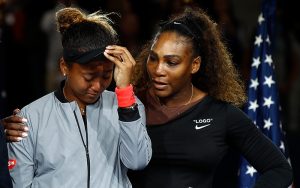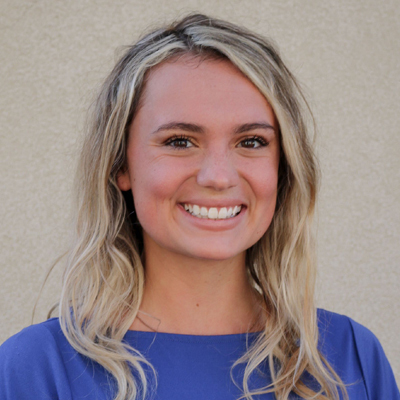
Naomi Osaka withdrew from the French Open Monday, citing the expectations of press interviews and the anxiety it triggers. Her decision has led to a debate about what media responsibilities entail. (Photo by Cameron Spencer/Getty Images)
PHOENIX – On the final day of mental health awareness month, the tennis world watched one of its most popular athletes withdraw from a prestigious competition because of issues related to anxiety and depression, triggering widespread debate about athlete responsibility and media coverage.
Naomi Osaka, the No. 2 ranked tennis player in the world, will not participate in the second Grand Slam of the season after announcing Monday on social media that she had withdrawn from the French Open and will “take some time away from the court.”
Osaka shared in the statement that she has battled depression since her 2018 U.S. Open victory over Serena Williams, which caused controversy after Williams was issued three code violations resulting in the loss of a point and a game. Osaka and Williams stood on the podium following the match while fans booed and Osaka cried.
Scottsdale psychologist Bettina Lehnert believes “PTSD comes in all kinds of forms.”
“It doesn’t have to be a life threatening event in order for it to have a strong impact on our emotions, because really how trauma expresses itself often is in the meaning that we attach to experiences,” she said. “So obviously it would have been very difficult to attach a positive meaning to that traumatic experience here with the crowd booing you.”
Osaka’s withdrawal followed her announcement in a separate tweet before the French Open that she would not partake in any media availability because she did not want to subject herself to the doubt press conferences bring to an athlete’s mind.

After her 2018 U.S. Open victory over Serena Williams, who was issued three code violations resulting in the loss of a point and a game. Naomi Osaka (left) cried as Williams comforted her. (Photo by Julian Finney/Getty Images)
Osaka stuck to her word and did not attend media availability after defeating Patricia Maria Tig in the first round.
She was fined $15,000 for not participating, and the four Grand Slam organizations released a joint statement threatening expulsion from the tournament and future ones if she continued to avoid media sessions, citing specific code of conduct violations.
“We have advised Naomi Osaka that should she continue to ignore her media obligations during the tournament, she would be exposing herself to possible further Code of Conduct infringement consequences,” the joint statement said.
As journalists and athletes digested and reacted to the situation, support for Osaka’s mental health recovery was strong but the debate of how athletes should be covered ensued.
Karen Crouse, a journalist for the New York Times for the past 16 years, has seen firsthand how important press conferences can be in allowing the public to see the athlete as more than just a performer.
“What I’ve found from the people I’ve covered, whether it’s Michael Phelps or Naomi Osaka, is that it’s their weaknesses and vulnerabilities that make them feel most relatable to people or relatable to the most people,” Crouse said. “There are people who will never understand what it’s like to stand across the net from Serena Williams and absorb that power and give it back to her as good as she gets, but can totally understand dealing with anxiety and depression.”
Brianna Turner of the Phoenix Mercury was one of several athletes who reacted to Osaka’s withdrawal.
On Monday she tweeted, “ I think sometimes people forget that athletes are worthy of respect and allowed to experience a full range of emotions.”
I really don’t like a lot of reactions/ responses to Kyrie having something thrown at him and Naomi withdrawing from competition. I think sometimes people forget that athletes are worthy of respect and allowed to experience a full range of emotions.
— Brianna Turner (@_Breezy_Briii) May 31, 2021
Turner expanded on her feelings in a press conference Tuesday.
“I feel like people were just kind of looking at athletes for their entertainment value and not for their actual human aspect,” Turner said. “We’re humans first, athletes second.
“So I just wanted people to take a second thought and realize that just because they make a lot of money and they’re in the public eye doesn’t mean that they’re not worthy of respect and their privacy.”
Crouse wholeheartedly agreed.
“It is super important for journalists to never forget that the performers they are covering are people first, and to always try to come at your questions and your interviews from that perspective, that I’m talking to a person and not just a performer,” Crouse said. “I want to put myself in the shoes of that person. How would I want to be treated in this situation, whatever it is, in victory or defeat. I think that’s a good place for journalists to start.”
Despite the acknowledgement and need for athletes to be recognized as people first, the need for their availability remains present during tournaments.
“It’s a codependent relationship,” Crouse said. “Sometimes it’s unhealthy but it can work for both parties, but it’s a codependent relationship without people attending the event and writing about it, or broadcasting it there, Naomi Osaka is not the highest earning female athlete. But do you really want to expose her to this if it’s going to cause her to withdraw from a major? So there I don’t think there’s an either/or.”
One solution could be to dismiss the blanket rule of having every athlete interact with the media in the same way, Crouse said.
“Not everyone processes things the same. So you can’t say we’re going to have this blanket
perceived protocol for dealing with mental health issues because everyone responds to things differently and what will be anxiety inducing for one athlete won’t be at all for another. So you have to almost be willing to take things on a case to case basis and be flexible and adaptable.”
Lehnert echoed these sentiments.
“You cannot judge what another person’s experience is when you don’t have the same biological forces at play and the same life experiences, or whatever that is going into what ends up getting expressed,” Lehnert said. “So I think, first of all, just trying to understand it and educate ourselves about mental health issues and how they can impact people.”
As the world awaits Osaka’s return to tennis, the conversation about the relationship between athletes and the media will surely continue, but it is the mental health aspect Crouse hopes will not be lost as she has seen happen before.
“Hopefully this leads to more of these conversations. My worry is that this is in the news and then by next week we’ve moved past it just like Michael Phelps’s issues,” Crouse said about the Olympic swimmer’s battle with depression.
“I think there’s plenty of culpability to go around and if nothing else comes of this I hope it’s a moment of self reflection for everybody involved.”
The expectations of athletes to participate in media availabilities complicate the issue.
The joint statement released by the Grand Slam organizations said, “As might be expected, repeat violations attract tougher sanctions including default from the tournament (Code of Conduct article III T.) and the trigger of a major offence investigation that could lead to more substantial fines and future Grand Slam suspensions (Code of Conduct article IV A.3.).”
Article III T of the Code of Conduct specifically states “unless injured and physically unable to appear, a player or team must attend the post-match media conference(s) organised immediately or within thirty (30) minutes after the conclusion of each match.
“Violation of this Section shall subject a player to a fine up to $20,000.”
Osaka said in her statement that “I think now the best thing for the tournament, the other players and my well-being is that I withdraw so that everyone can get back to focusing on the tennis going on in Paris.”

